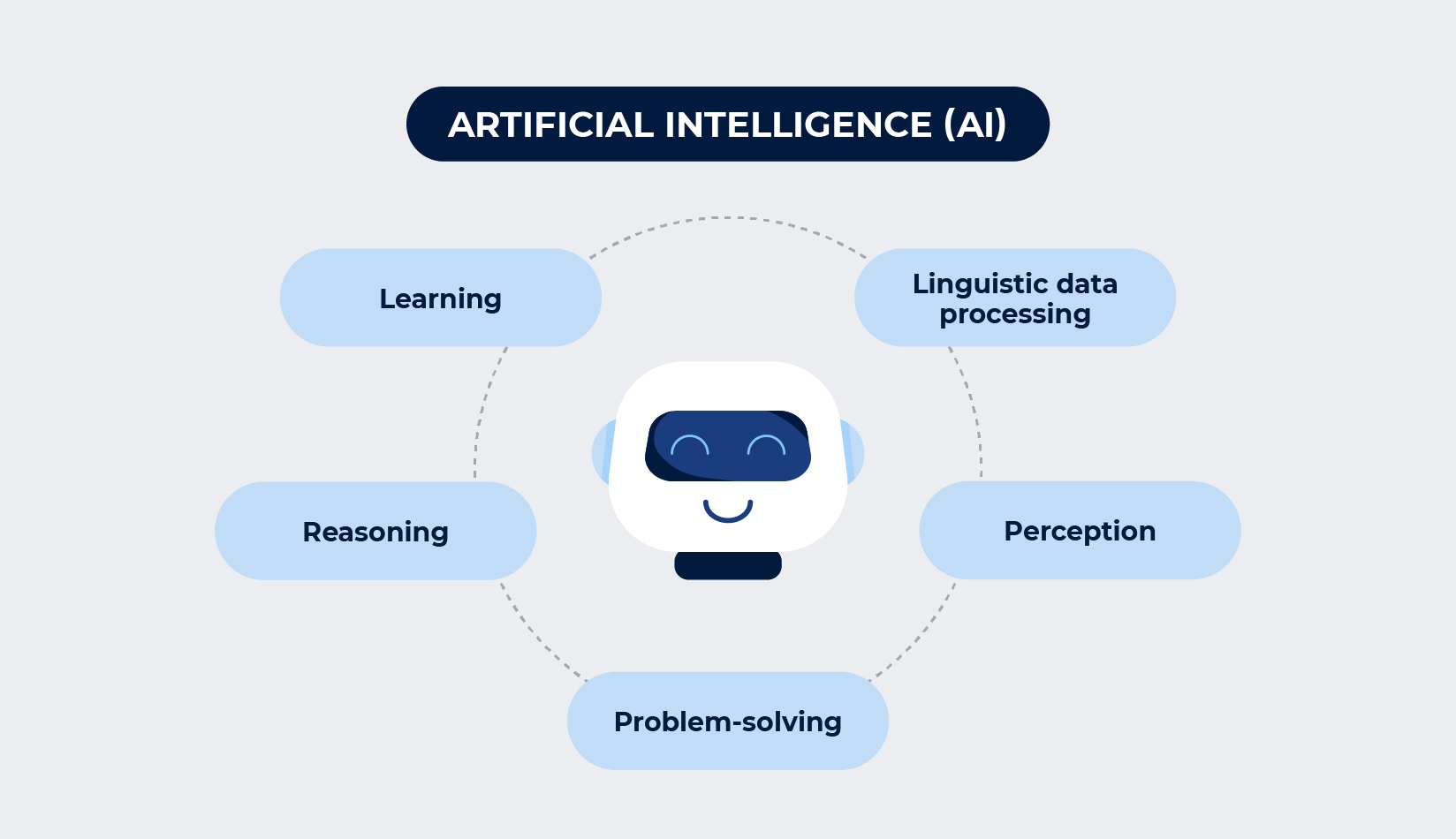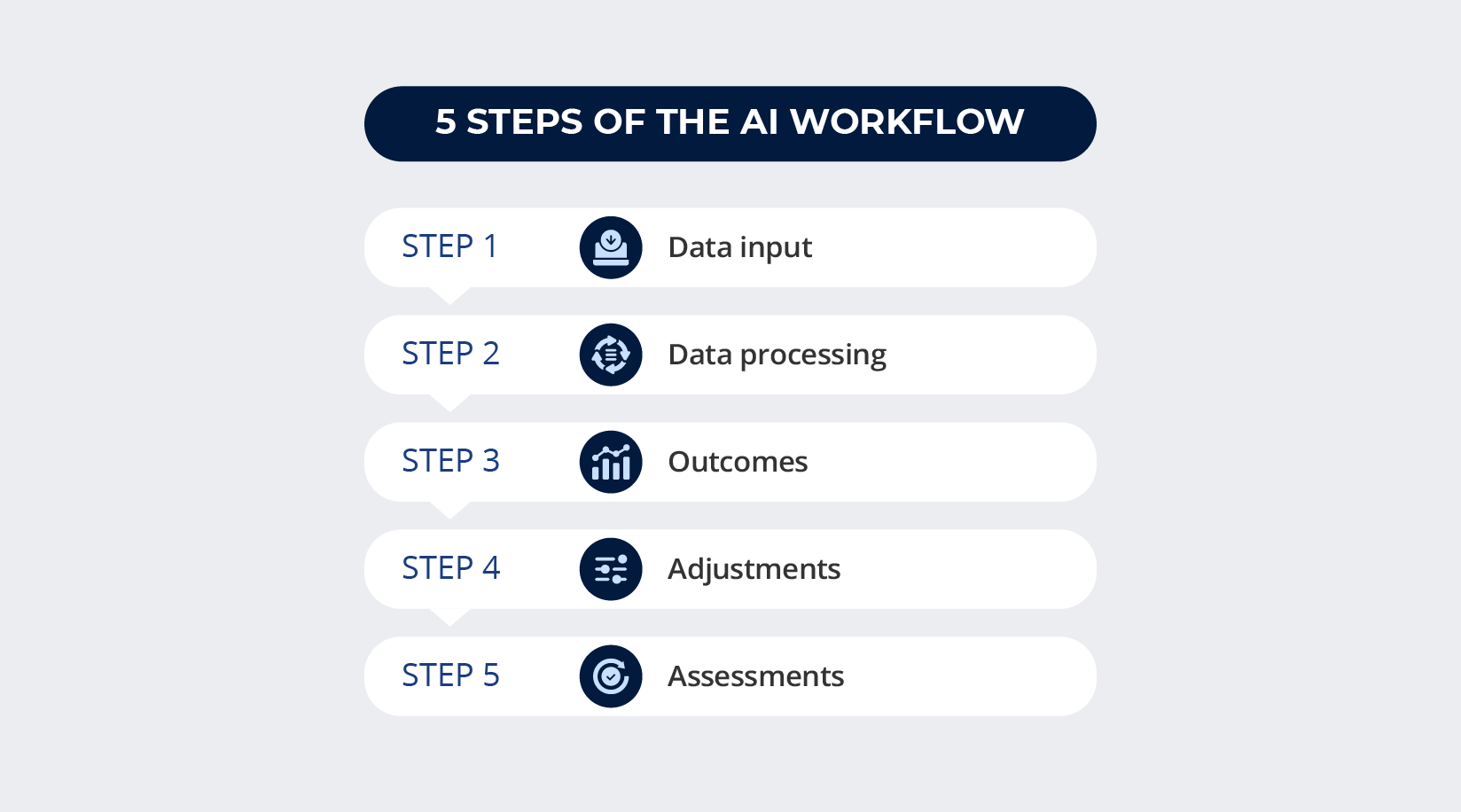Artificial intelligence (AI) is no longer just an invention of science-fiction writers and filmmakers. Today, AI software solutions are widely applied across multiple industries to accelerate business processes, make predictions, and personalize services, among other functions.
A 2023 global survey by Statista revealed that 32% of CMOs and 23% of CEOs have already integrated AI into their operations, while 39% and 43%, respectively, are exploring future adoption.
The AI market is expected to exceed $1.8 trillion by 2030.
Artificial intelligence is a young and fast-growing field, driven by advancements in related technologies like machine learning, cloud computing, big data, and analytics. While AI holds a lot of promise, it can also present challenges.
Many clients have come to SaM Solutions for AI-based projects, though often unsure of how to articulate their needs or where to start. Our experts guided them through setting clear goals, choosing the right technologies, and creating detailed project plans. As a result, we’ve been implementing AI solutions for several years now, ranging from department-wide chatbots to computer vision systems that optimize production lines.
We’ve compiled this guide to help you understand how to create AI software, keep pace with the competition, and squeeze more value out of modern technology.
What Is Artificial Intelligence?
As the common definition goes, artificial intelligence (AI) is a comprehensive technology focused on mimicking human intelligence.

Specifically, it imitates the following cognitive functions:
- Learning: AI systems analyze data, recognize patterns, and continuously improve through experience.
- Reasoning: AI applies logical rules, draws conclusions from data, and evaluates multiple factors to make decisions or predict outcomes.
- Problem-solving: AI breaks down complex problems into manageable parts and finds solutions by evaluating different approaches.
- Perception: AI uses sensors, cameras, and other inputs to interpret the physical world, allowing it to recognize objects, sounds, or environments.
- Linguistic data processing: AI solutions handle and produce human language, which means they understand, interpret, and respond to written or spoken communication.
Since artificial intelligence is an umbrella term, it encompasses several key concepts:
- Machine learning (ML) — a branch of AI that focuses on enabling systems to learn from data and perform better over time without explicit programming.
- Deep learning (DL) — a branch of machine learning that uses neural networks with many layers (hence the term “deep”) to capture and model intricate patterns within large datasets.
- Natural language processing/Natural language generation (NLP/NLG) — NLP focuses on the interaction between computers and human (natural) languages, aiming to help machines comprehend and interpret human language. NLG, a subfield of NLP, is concerned with generating coherent and contextually relevant written or spoken narratives.
- Computer vision — a branch of AI that enables machines to interpret and understand the visual world. Using algorithms and models, computer vision systems can process, analyze, and make decisions based on images or videos, mimicking human visual capabilities. It plays a critical role in applications such as image recognition, object detection, and facial recognition.
- Robotics — an interdisciplinary field within AI that focuses on designing, constructing, and operating robots. Robotics draw on artificial intelligence to enable robots to perform complex tasks autonomously or semi-autonomously. It often combines capabilities like machine learning, computer vision, and natural language processing, with applications in industries such as manufacturing, healthcare, and autonomous vehicles.
AI-powered solutions can fully take over certain complex cognitive tasks, often executing them faster and more efficiently than humans.
How Does AI Work?

It’s accurate to say that artificial intelligence operates based on large volumes of data. Here’s a breakdown of the key steps in the AI workflow:
Raw data is collected from various sources, such as sensors, databases, or user interactions, and fed into the AI solution. This data can be structured (e.g., spreadsheets) or unstructured (e.g., text, images).
The input data is cleaned, organized, and transformed into a usable format. This step may include filtering out irrelevant information, filling in gaps, and normalizing data for consistency.
The AI solution generates predictions, classifications, or recommendations based on the processed data. These outputs can range from insights in reports to actions in automated systems.
Depending on the outcomes, the AI solution can be fine-tuned. This involves modifying algorithms, retraining models, or incorporating new data to improve accuracy or efficiency.
The model’s performance is evaluated against predefined metrics to prove that the AI solution delivers the expected results and maintains reliability.
These steps create a continuous loop of improvement and optimization for AI systems.
AI vs. Traditional Programming
AI differs from traditional programming in how tasks are approached. In traditional programming, developers explicitly code rules and instructions for the system to follow. In AI, especially with machine learning, the system learns from data and adjusts its behavior based on patterns, without needing predefined rules. Artificial intelligence systems adapt and improve gradually, while traditional programs rely on fixed, manual updates to change functionality.
Steps for Building AI Software
The artificial intelligence industry is in constant flux, with AI solutions emerging rapidly. A common question for companies and business owners is how to build AI software from scratch to gain a competitive edge.
While the process may seem daunting, it’s more manageable than it appears, provided you have the support of an experienced and reliable software development company. Let’s break it down in detail.
1. Problem identification and goal setting
The first step in AI software development is to define the specific problem the AI solution should address and set clearly measurable goals. This involves understanding business challenges, target outcomes, and limitations.
Pro tip
Engage stakeholders from various departments (e.g., marketing, sales, operations) to clarify the desired outcomes and set key performance indicators (KPIs).
Example: A retail company may want to predict customer demand to optimize inventory management. The goal would be to develop a predictive model that accurately forecasts product sales based on historical data.
Tools: While problem identification doesn’t typically require specific software, tools like Miro or Trello can help teams collaborate and map out the AI project’s goals.
2. Data gathering and preparation
Data is the backbone of any AI solution. The quality, quantity, and relevance of the data directly affect the accuracy and operation of the AI model. This step includes:
- Data collection: Gather relevant data from various sources (internal databases, APIs, third-party systems, etc.).
- Data cleaning: Remove inconsistencies, errors, or duplicates.
- Data transformation: Convert raw data into formats suitable for AI models.
Example: For customer churn prediction, the retail company collects customer purchase history, engagement data, and customer support interactions.
Tools for data gathering: APIs like Twitter API and Facebook Graph API for social data; web scraping tools like BeautifulSoup and Scrapy.
Tools for data preparation: Pandas and NumPy (Python libraries) for data cleaning and manipulation; Google BigQuery for large-scale data analysis; Talend and Apache NiFi for data integration and cleaning.
3. Choosing tools and platforms
In this step, you decide which tools, frameworks, and platforms will best suit your AI development process. The choice depends on the type of AI solution (machine learning, deep learning, NLP, etc.), the team’s familiarity with certain technologies, and available resources.
Popular tools and platforms
- Programming languages: Python, Java, R, Julia.
- Frameworks: TensorFlow, PyTorch, and Keras for deep learning; scikit-learn for traditional machine learning.
- Cloud platforms: Google Cloud AI, Microsoft Azure, Amazon SageMaker.
4. Algorithm design or model selection
This is where you choose the most appropriate algorithm or model based on the problem you’re solving. Depending on the data and business goals, this could be:
- Supervised learning (e.g., classification, regression)
- Unsupervised learning (e.g., clustering)
- Reinforcement learning for decision-making processes
Example: The retail company explores classification algorithms like logistic regression, random forest, and support vector machines (SVM) to predict whether a customer will churn (yes/no).
5. Training the algorithm or model
After picking the algorithm or model, the next step is to train it on your dataset. This means splitting the data into training and validation sets, then feeding it into the model so it can learn the patterns between the input features and the target outputs.
Example: The retail company trains the model using 80% of the customer data, while the remaining 20% is set aside for validation.
Tools for training AI models: TensorFlow, PyTorch, Keras, scikit-learn, Vertex AI, OpenNN.
6. Assessing the AI system
After training, the model’s performance must be evaluated. This step involves assessing the model using metrics that reflect its accuracy, precision, recall, F1 score, or other relevant KPIs. Cross-validation is also performed to guarantee the model generalizes well to new data.
Example: The retail company uses accuracy and F1 score to measure how well the model predicts customer churn. They also assess if the model is overfitting by performing cross-validation.
Tools for assessment: scikit-learn for performance metrics; TensorBoard for visualizing model effectiveness in deep learning; MLflow for tracking experiments and metrics across multiple runs; hyperparameter tuning tools like Optuna or GridSearchCV.
7. Implementing your AI solution
Once the AI model is fine-tuned and assessed, it’s ready for deployment. This step involves integrating the AI solution into the existing software infrastructure. The deployment strategy might include:
- Building APIs for other systems to interact with the AI model.
- Ensuring the model can scale to handle real-time data.
Example: The retail company integrates the churn prediction model with their CRM system, so customer service teams can receive churn risk alerts in real time.
Tools: Flask or FastAPI for building APIs; Docker and Kubernetes for containerization and scaling; Amazon SageMaker or Google Cloud AI for deploying models in production environments.
8. Monitoring and ongoing updates
After deployment, continuous monitoring is essential to prove that the AI model performs well in real-world conditions. As data changes, models may need retraining or updates to remain accurate. Monitoring involves:
- Tracking the model’s predictions and comparing them to real outcomes.
- Detecting any performance drift or degradation in the long run.
- Implementing a feedback loop for continuous improvement.
Example: The retail company notices that customer preferences shift during holiday seasons and retrains the churn model every quarter to account for new behaviors.
Tools: Prometheus for real-time monitoring of deployed models; Grafana for visualizing metrics; MLflow for versioning models and tracking updates; DataRobot for monitoring model performance and automatically triggering retraining when needed.
Best Practices for AI Development
1. Start with a clear, well-defined objective
Before diving into AI development, it’s critical to establish a clear and specific objective for what you aim to achieve. This keeps the project relevant to business needs, preventing scope creep or wasted resources. Define the problem you want to solve, the value AI will bring, and how success will be measured.
Pro tips
– Break down complex issues into smaller, manageable components.
– Engage key stakeholders early to align on business goals and AI capabilities.
2. Prioritize high-quality, relevant data
AI models rely heavily on data, so providing accurate, clean, and relevant data is vital. Poor data quality can lead to inaccurate predictions and models that fail to generalize. Prioritize data quality over quantity, making sure that the data reflects the real-world environment the model will operate in.
Pro tips
– Implement robust data-cleaning processes.
– Regularly audit and update the data to maintain its consistency.
– Balance the dataset to prevent bias and improve model fairness.
Example: For a smart system that detects fraudulent transactions, use a balanced dataset of both fraudulent and legitimate transactions, as well as include up-to-date trends in fraudulent behavior.
3. Build scalable and maintainable systems
AI systems should be designed for scalability and ease of maintenance. As businesses grow or their needs change, AI models must handle larger datasets and more complex requirements. Additionally, the model may need to be updated or retrained as new data becomes available.
Pro tips
– Use modular code and architecture to make updates and improvements easier.
– Opt for cloud-based AI platforms that offer flexibility in scaling.
– Document your model development process to facilitate knowledge transfer.
Example: A healthcare company developing a patient diagnostic system uses Docker to containerize their AI model, enabling seamless scaling across hospitals with different workloads.
4. Focus on iterative development and testing
AI development should take an iterative approach where models are constantly trained, tested, and improved. This way, problems like overfitting or performance drift can be spotted early and addressed quickly.
Pro tips
– Use cross-validation and A/B testing to compare different models and choose the one that performs best.
– Implement regular testing in real-world environments to verify the AI model adapts well to production data.
– Continuously retrain models to account for changes in data patterns or business needs.
Example: A recommendation engine for an ecommerce platform can undergo A/B testing to compare the performance of different algorithms in suggesting products that lead to higher sales conversions.
5. Incorporate transparency and ethical AI practices
When developing artificial intelligence software, it’s important to think about ethical issues like bias, fairness, transparency, and accountability. As AI systems play a bigger role in decision-making, it’s crucial to make sure they’re fair, easy to understand, and clear to users.
Pro tips
– Use interpretable AI models, especially in high-stakes industries like healthcare or finance, where decision-making needs to be transparent.
– Implement fairness checks to prevent bias in outcomes (e.g., confirming algorithms do not discriminate against certain groups).
– Comply with legal and ethical guidelines regarding data privacy, transparency, and accountability.
Example: A bank using AI for credit scoring needs to make sure its model doesn’t unfairly judge applicants based on their race, gender, or economic background.
Challenges of Building Artificial Intelligence
Now that you have an understanding of how to make your own artificial intelligence software, let’s look at some difficulties you may encounter.
Data quality and quantity
| Insufficient data | Data inconsistency | Imbalanced data |
| Some AI applications require vast amounts of data to train models effectively. Small datasets can lead to underfitting, where the model fails to learn patterns adequately. | Real-world data is often noisy, incomplete, or inconsistent, requiring significant preprocessing before it can be used for AI development. | In classification tasks, if one class dominates the dataset, the model may become biased toward the majority class and fail to generalize well for minority classes. |
Algorithm selection and optimization
| Algorithm complexity | Model overfitting | Hyperparameter tuning |
| Some algorithms, like deep neural networks, can be computationally expensive and difficult to interpret, while simpler algorithms might not capture the full complexity of the data. | If a model is too complex, it may perform well on training data but poorly on unseen data (overfitting). Regularization techniques and cross-validation are needed to mitigate this. | Many algorithms require tuning hyperparameters (e.g., learning rate, number of layers in a neural network) to perform optimally, which can be time-consuming and computationally intensive. |
Computational resources and scalability
| Hardware limitations | Scalability | Cloud vs. on-premises |
| Training large AI models, such as deep learning networks, can require GPUs, TPUs, or specialized hardware. Without the proper infrastructure, training times can stretch to days or even weeks. | As the size of the dataset or the complexity of the model increases, the computational resources and time required also grow exponentially. Ensuring that the AI system can scale with business needs is crucial. | Organizations must decide whether to invest in expensive on-premises hardware or rely on cloud services like AWS, Google Cloud, or Azure for scalable AI development. |
Ethical and regulatory considerations
| Bias and fairness | Data privacy | Transparency and explainability |
| Models trained on biased data can produce discriminatory outcomes, especially in sensitive domains like hiring, lending, or law enforcement. Maintaining fairness and avoiding bias in AI decision-making is a complex task. | AI systems usually depend on a lot of personal data. It’s really important to follow data privacy rules like GDPR (General Data Protection Regulation) or CCPA (California Consumer Privacy Act), especially when dealing with sensitive info. | Some AI models, such as deep learning networks, are often referred to as “black boxes” because their decision-making processes are difficult to explain. Providing transparency and interpretability is crucial for building trust with users and regulators. |
Why Choose SaM Solutions?
With over 30 years of experience in multi-technology software development, SaM Solutions delivers innovative, reliable solutions tailored to particular business requirements. Our well-established, transparent processes keep projects running smoothly, with clear communication every step of the way. We follow global security standards and regulations to provide top-notch data protection and compliance. With a deep understanding of various technologies and a commitment to quality, we offer a trusted partnership for AI-driven innovation across industries.
Still uncertain about how to make your own AI software? Don’t hesitate to contact SaM Solutions’ experts for a consultation.
Conclusion
Creating artificial intelligence software involves understanding the core principles of AI, following a structured development process, and leveraging the right tools and frameworks. From data collection and model training to testing and deployment, each step requires careful planning and execution.
Adopting best practices such as iterative development, thorough testing, and ensuring ethical AI usage can help navigate the challenges of AI development, including data quality and model biases. By staying up to date with the latest tools and trends, developers can build robust, scalable AI solutions that drive innovation across industries.



















 The Latest 15 Information Technology Trends in 2024
The Latest 15 Information Technology Trends in 2024 Top 10 Embedded Software Development Tools
Top 10 Embedded Software Development Tools IaaS vs. PaaS vs. SaaS: What’s the Difference?
IaaS vs. PaaS vs. SaaS: What’s the Difference? 10 Examples of Predictive Analytics
10 Examples of Predictive Analytics












 Web App Development Cost in 2025 [Key Price Factors]
Web App Development Cost in 2025 [Key Price Factors] 13 Best React Development Tools in 2025
13 Best React Development Tools in 2025 Top 10 Mobile App Development Trends 2025
Top 10 Mobile App Development Trends 2025 Top IoT Industry Trends in 2025
Top IoT Industry Trends in 2025 Java Web App Security: Everything You Need to Know
Java Web App Security: Everything You Need to Know